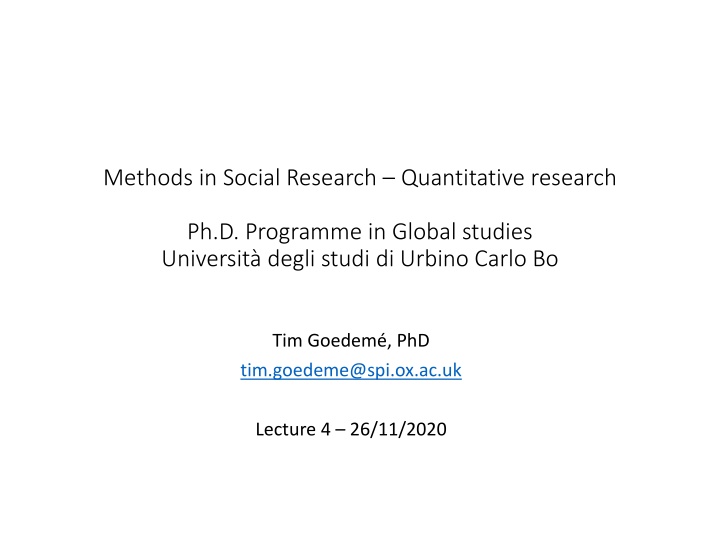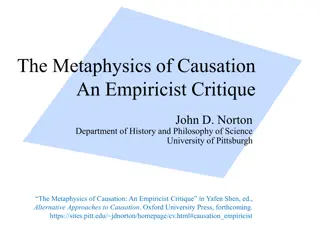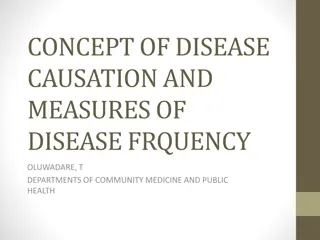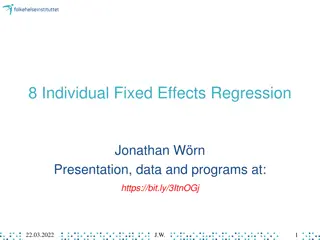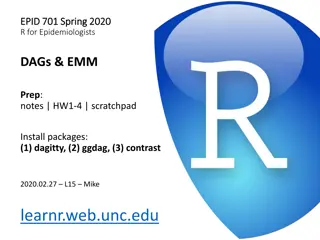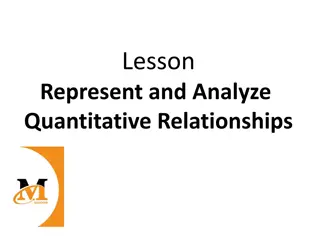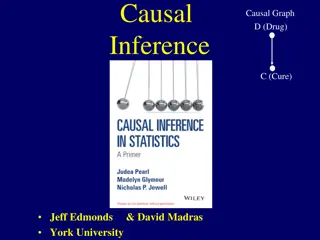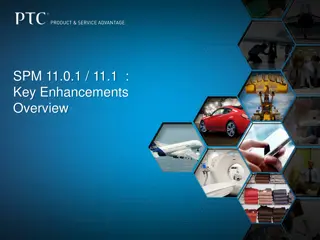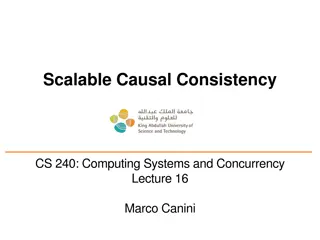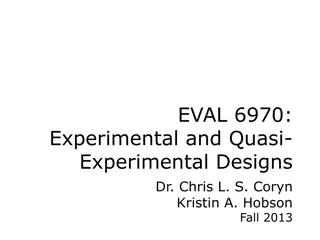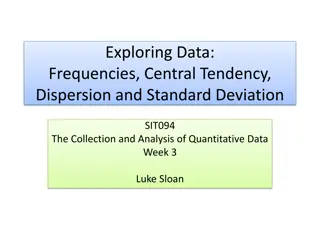Quantitative Research Techniques for Identifying Causal Relationships
Quantitative research methods like experiments, regression analysis, and tax-benefit microsimulation are explored for identifying causal relationships in social research. The lecture discusses experimental design, including random assignment, control groups, and potential biases. Risks and limitations of experimental designs, such as selection bias and external validity issues, are also highlighted.
Download Presentation

Please find below an Image/Link to download the presentation.
The content on the website is provided AS IS for your information and personal use only. It may not be sold, licensed, or shared on other websites without obtaining consent from the author.If you encounter any issues during the download, it is possible that the publisher has removed the file from their server.
You are allowed to download the files provided on this website for personal or commercial use, subject to the condition that they are used lawfully. All files are the property of their respective owners.
The content on the website is provided AS IS for your information and personal use only. It may not be sold, licensed, or shared on other websites without obtaining consent from the author.
E N D
Presentation Transcript
Methods in Social Research Quantitative research Ph.D. Programme in Global studies Universit degli studi di Urbino Carlo Bo Tim Goedem , PhD tim.goedeme@spi.ox.ac.uk Lecture 4 26/11/2020
Overview of the course 1. Introduction to quantitative research and social indicators 2. Survey data and total survey error, including sampling variance 3. Social indicators and policy indicators 4. Quantitative research techniques to identify drivers 5. Setting up your own research project
1. Identifying drivers and causes in social research Lots of quantitative research is not just aimed at description and association, but at causation Two possibilities: causes of effects and effects of causes The key trick that must be achieved: building a valid and convincing counterfactual situation Hard causes are often hard to identify
1. Identifying drivers and causes in social research Three techniques discussed in this lecture: Experiments (Interlude: causes vs. drivers and determinants ) Regression analysis (also applied in experiments) Tax-benefit microsimulation
Experimental design Typically an experimental design is required for identifying causal relationships: People are randomly assigned to groups (control and treatment/intervention group) => solves problem of selection bias Both observed and unobserved heterogeneity Manipulate one or more factor in treatment group: however, be conscious about what one factor is (e.g. placebo effect ) More sophisticated designs which test more variations Independence assumption: if treatment is assigned randomly, then difference in outcome between treated and non-treated equals expected average causal effect Field experiment vs. lab experiment
Experimental design Risks and limitations of experimental designs include: Random biased assignment to control and intervention groups ( random bad luck ) Only feasible for specific questions and specific interventions: Big policy changes, ethical issues Often with specific sub-populations: strong internal validity, weak external validity Assumption of constant effect: effect on each unit is equal to average causal effect Stable-Unit-Treatment Value Assumption (SUTVA): non-interference of units (treatment of one unit does not affect outcome of other unit) (micro-meso- macro level) => external validity? Many experiments are required before fully understanding mechanisms: good theories and other types of research are required (including qualitative research) Feasible with effects of causes, not causes of effects
1. Identifying drivers and causes in social research So what if experimental setup is not feasible or desirable?
1. Identifying drivers and causes in social research If a study does not include random assignment, selection bias is probably a very important challenge for causal statements. Given that random assignment is not always feasible (e.g. when studying causes of effects, or effects of causes happened in the past): lots of quasi- experimental designs. This usually involves panel data: multiple measurements on the same subjects spread out in time. For effects of entire welfare states or big policies that include entire populations: comparative research
1. Identifying drivers and causes in social research Key question is always: can one situation / unit of observation / group / group of countries be a good counterfactual for the other? Counterfactuals in comparative research: what could be if something would be different e.g. can one country be the counterfactual of another country? Can a country s past be a counterfactual for the present or future?
Source: Ostry, J. D., A. Berg, and C. G. Tsangarides. (2014), Redistribution, Inequality, and Growth, International Monetary Fund, Washington, D.C., p. 16
1. Identifying drivers and causes in social research Important to always think about limitations Many studies are required to arrive at solid conclusions, using different data and approaches Yet, can build a body of evidence , which increases insight and maximises potential for better understanding causes of effects, or potential causes when experimental designs are not possible Often less need for the Stable-Unit-Treatment Value Assumption (SUTVA): Allows for taking account of effect treatment of one unit has on the outcome of other unit
1. Identifying drivers and causes in social research A driving factor / determinant: something which makes a clear contribution, even as an intermediate step in a causal link, but is not a pure cause in itself May be useful to understand for policy makers and helpful for designing policies, even if no direct causal link Are an essential part of theory building, exploring likely causal mechanisms and also testing hypotheses. For instance: Differences in demographic composition and poverty rates Differences in earnings distributions and inequality Association between education and willingness to vaccinate ( controlling for other factors)
1. Identifying drivers and causes in social research In what follows to very different techniques to analyse drivers/determinants, causes and effects : Regression analysis Tax-benefit microsimulation Both refer to a group of techniques, and both types of analysis can have an appropriate causal interpretation only in very specific setups, circumstances and under specific assumptions.
Regression analysis studying how multiple independent and control variables are simultaneously associated with a dependent variable of interest A massive amount of different regression techniques, from simple to very advanced Should always fit the research question and purpose of the exercise as well as possible
Kyzyma, I. (2020), 'How Poor Are the Poor? Looking beyond the Binary Measure of Income Poverty', The Journal of Economic Inequality, Vol. 18, pp. 525-49. Regression coefficients variables intercept R = % of explained variance compared to variance around the (unconditional) mean
Regression analysis Interpretation Regressions plot a line / fit an equation which minimizes the distance between the predicted value and the original observations (i.e. the residuals) Regressions can always be written in an equation. E.g. for the previous table (first regression): Normalised poverty gap = 0.2879+0.0029*age -0.0001*age - 0.0006(females) 0.0002*age(females)-0.0408(Couple)-0.0681(Single parent)-0.0072(Other)- 0.0072*nchildren + Normalised poverty gap = (poverty line - income)/poverty line Coefficient>0 => the association with the dependent variable is positive (if one increases, so does the other); coefficient <0 => negative association (if one increases, the other decreases) Interactions: variables are multiplied with each other. when there are good reasons to suspect that the association with one variable, depends on the value of another variable Association between reading books and IQ can be expected to be stronger for those who can read than for those who cannot: IQ = nbooks + ability to read + nbooks*ability to read
Regression analysis Interpretation Unless experimental setup/quasi-experimental design: coefficients indicate association, not causation => don t write/read them as effects of X on Y . (Pseudo) R squared is a goodness-of-fit measure, varying between 0 (equation does not fit the data better than the mean) and 1 (the observations can be perfectly predicted by the equation) In cross-sectional regressions related to human behaviour/situations, R is often lower than 0.5. The significance of regression coefficients of individual variables is more telling in that case
Regression analysis 1. Check dependent variable 2. Check characteristics of model, number of observations and goodness-of-fit 3. What kind of relation is being estimated: correlation or causation? Which variables are considered treatment variables ? Does this correspond to a (quasi-)experimental design? 4. Check the type of variables that are included: dummy, nominal, ordinal, continuous? 5. Check for interactions: if there is an interaction the variable has to be interpreted in conjunction with the interaction 6. Write out the underlying equation to see what is exactly estimated 7. Are coefficients significant? Is the effect size substantial and does it make sense? (coefficients have to be compared to the variation of the variable in the dataset) 8. What have the authors done to validate the model? Do they describe how well it fits the data? Do they point to the limitations and potential bias in the estimated coefficients? Are sensitivity tests available and discussed?
Regression analysis Regression analysis is a very common technique to study the association between variables Very powerful technique which helps to gain insight into social phenomena, but most of the time cannot have a causal interpretation: association is not (necessarily) causation! Simplification is required, with too complex models, interpretation becomes too complex as well (unless prediction is more important than interpretation) There are an immense amount of regression-based techniques, with lots of different specifications (There are also many other multivariate techniques, with different purposes (e.g. latent class analysis, factor analysis, cluster analysis, ))
Tax-benefit microsimulation Microsimulation is a term used to describe a wide variety of modelling techniques that all operate at the level of individual units (such as persons, firms or vehicles) to which a set of rules is applied to simulate changes in state or behaviour. (Figari et al., 2014 => see text on Google Drive) With tax-benefit microsimulation, the legislation, rules and regulations of tax liabilities and benefit entitlements are programmed in a software package. This is subsequently applied to individuals and households, to compute the taxes and social contributions they have to pay and the social benefits they would receive, as well as their disposable income, given their characteristics, situation and various sources of income This can be useful for: Imputing missing information in datasets (e.g. gross or net incomes) Ex-ante policy evaluations Ex-post policy evaluations Nowcasting and forecasting
Tax-benefit microsimulation Two types: hypothetical household simulations vs. population-based simulations Hypothetical household simulations, model family simulations or standard simulations use hypothetical households , defined by the researcher Population-based simulations start from a sample or population data, and work with real households EUROMOD is the tax-benefit microsimulation model for Europe, same platform is also used for many other countries https://www.euromod.ac.uk/.
Tax-benefit microsimulation 1. Example of an ex-ante evaluation: a simple child benefit reform in German Cf. Hufkens, T., T. Goedem , K. Gasior, et al. (2019), 'The Hypothetical Household Tool (HHoT) in EUROMOD: a New Instrument for Comparative Research on Tax-Benefit Policies in Europe', International Journal of Microsimulation, Vol. 12, pp. 68-85. We combine hypothetical household simulations to see how the policies interact in concrete cases, population-based simulations on EU-SILC to assess the distributive effects in the population (in this case poverty)
Tax-benefit microsimulation Children in single-parent families in Germany have a relatively high poverty risk We reform the existing child benefit system: currently the amount/child increases with the number of children. We replace this with a system of equal amounts/child, independently of the number of children, but with much higher benefits for single-parent families This is a budget-neutral reform: the total volume of child benefits is not changed Step 1: define the hypothetical households
The means-test takes child benefits into account
Tax-benefit microsimulation This is an example of comparing two dependent samples: the units of observation are the same in the baseline and the reform scenario Note: with 90% confidence level, the S.E. must be multiplied with 1.65 to compute the confidence bounds
Tax-benefit microsimulation 2. Example of an ex-post simulation Have tax-benefit reforms contributed to more, or less inequality? Authors use the sample of one year, and then apply the tax-benefit system of another year, recomputing all income components This way, other population characteristics stay fixed (employment, distribution of market incomes, demographic composition) The result is the pure effect of policy changes, with some assumptions (cf. below) Decoster, A., S. Perelman, D. Vandelannoote, et al. (2018), Which way the pendulum swings? Equity and efficiency of 26 years of tax-benefit reforms in Belgium, Herman Deleeck Centre for Social Policy, Antwerp.
Tax-benefit microsimulation How much better off are were people living in Belgium under the 2018 system compared to the 1992 tax-benefit system? Source: Decoster et al., 2018
Tax-benefit microsimulation Hypothetical household simulations Strengths Easy to interpret Show in detail how policies interact with each other Can be used to construct policy (input) indicators which are not dependent on the composition of the population Limitations Cannot be used to extrapolate to total effects in the population (population- based microsims required) Representative for the tax-benefit system? Hard to aggregate effects across hypothetical households Only when effect is relatively similar across households, or when a large number of households is simulated Often illustrative rather than conclusive, except when similar findings can be expected for other household types A good selection of characteristics of the hypothetical households is key
Tax-benefit microsimulation Population-based microsimulations Strengths Full heterogeneity of population => beyond average effects , and representative of population Ex ante evaluations (effects of causes) + ex-post evaluations (causes of effects) Analysis of singular cases (i.e. specific events, e.g. what was the inequality impact of the great recession? Counterfactual for same persons (cf. fundamental problem of causality ) Interactions between policies + interactions between individuals to some extent taken into account: weaker SUTVA assumption required
Tax-benefit microsimulation Limitations Data quality measurement error, missing variables (e.g. wealth, contribution record), representativeness, sample size Sampling & non-sampling errors are important! Mismatch with existing administrative aggregate data Quality simulation model: Not all policies simulated (lack of data & complexity, e.g. pensions) Non-take up and tax evasion not adequately modelled Discretionary and local measures not adequately modelled
Tax-benefit microsimulation Limitations First-order effects: direct effect ( morning-after effect ) Second-order effects: behavioural changes Labour supply models Models of consumption (e.g. estimate effect on VAT) Demographic effects, (Reweighting vs. simulation) Third-order : general equilibrium (inflation, labour demand, ) => Second, and third order effect may substantially change conclusion! In other words the pure policy effect identified above, is only the direct effect.
Conclusion Without (successful) random assignment, an identification of the effects of causes is very hard Experiments are a very powerful tool to identify effects of causes, with a high level of internal validity External validity is often limited, and often many experiments as well as lots of other types of research (and theory) are required to fully understand the causal mechanism Experiments are not always feasible or desirable, and can be applied only in case of specific research questions
Conclusion Regression techniques are a powerful tool to analyse and understand the association between variables Coefficients can only have a causal interpretation if observations on that variable were randomly assigned to a control and treatment group Quasi-experimental designs try to mimic this random assignment or try to find a convincing counterfactual in other ways Most often, this allows for identifying drivers rather than point to causes But these drivers and determinants are often important pieces of the puzzle And this group of techniques has a much broader range of applications, including studying causes of effects, rather than just effects of causes
Conclusion Tax-benefit microsimulation: two types A very powerful tool for ex-ante and ex-post policy evaluations Can be used for building counterfactuals in a very different way
2. Setting up your own research project 1. Steps when doing survey data analysis 2. Tips, tricks and tools 3. Q & A
2. Setting up your own research project 1. Define research topic 2. Read and identify interesting research question Exciting and interesting Relevant Within abilities and feasible within timeline Research nearly always takes more time than anticipated 3. What would the ideal data and research setup look like to answer the question in a valid and reliable way? Is generalisation required? Is it a descriptive, correlation or causal question? What kind of qualitative and quantitative information is required? What would be the most convincing way of proving your point/finding out what you want to know? Is it a question that can be answered with real-world data and methods? Is the research question of adequate size for one research project? How should it be broken down into steps/research projects? Repeat process to identify one project and the ideal data and methods
2. Setting up your own research project 4. Identify real-life data and research strategy Data and research strategy are connected Make sure research question, data and research strategy match (iterative process!) Do the data exist already? Of sufficient quality (check papers that use the data!)? Do they include the variables you need? Should you collect your own data? Explore options for accessing existing data Try to think now already about what kind of numbers, tables and graphs would be required / be most informative for answering the research question Update your methodological knowledge and make sure you fully understand the required research technique 5. Starting the project Identify, contact and, if necessary apply for approval from Ethical committees Get in touch with your DPO = Data Protection Officer: how should you store the data? What does the university offer you? What is the level of security required? Existing data: Apply for the data, in case of access to admin data: Data protection authority (https://www.garanteprivacy.it/) (follow local regulations) Open access?
2. Setting up your own research project 6. Read detailed documentation on the data for which you applied Sample design Sampling and non-sampling errors (see Total survey error paradigm!) Comparability across groups, places and time What other metadata do exist? Read papers that have used the same data source Read papers that use the same method of analysis (especially those published in high quality journals) 7. Access the data Adequate (secure) storage? => encrypt / password protect the data Adequate back-up of original data files? Use syntax so you can easily adapt and redo analyses Good documentation system in place for what you do with the data?
2. Setting up your own research project 8. Explore the data Sample design variables => do they match with documentation? Explore variables of interest Explore and understand patterns of missingness Should the research question be further refined? 9. Detailed descriptive analysis Always start with looking at the distribution of the variables you want to include Make scatterplots to see how variables are associated with each other Think about dimensions of Lecture 1 10. Analyze data in detail
2. Setting up your own research project 10. Analyse data in detail Internal and external validity of variables and indicators What would be the most relevant sensitivity analysis? Think also about how you will report the results 11. Interpret and evaluate the results of the analysis Research question adequately answered? What are the main conclusions? How do they speak to what you know from the literature? What are the main limitations of your work in terms of internal and external validity, reliability, comparability, ? 12. Report results and inferences from the data Smart selection of tables (when individual numbers are important) and graphs (distributions, associations) => indicators of statistical reliability!
2. Setting up your own research project 1. Throughout the process: talk to others 1. Your supervisor 2. Peers 3. Seminars, workshops and conferences 4. Reach out to people who have done similar research as the one you would like to do (after reading their work!) 2. Reading is important, but give it a clear direction, do not simply try to read everything that exists on a topic usually there is too much to read within a reasonable time! 3. Try to read, do research and write at the same time: document the steps you take, and when you read always think about how that will help you to write/nurture your paper
2. Setting up your own research project Statistical software: R, SPSS, SAS, Stata, What do other people in your department use? Talking to others is always helpful to help solve problems Protect your data: Veracrypt Sources of quantitative data: Eurostat (microdata + online database) UN, OECD, World Bank, Online repositories of data: e.g. https://www.nature.com/sdata/policies/repositories#social; https://www.opendatarepository.org/; check journal Data in Brief, and others Summer schools
2. Setting up your own research project Q & A Good luck with your own research!
Some suggestions for further reading Quantatitave data analysis (incl. regression) Wooldridge, Introductory Econometrics: A Modern Approach (various editions) Heeringa, S. G., B. T. West, and P. A. Berglund. (2010), Applied Survey Data Analysis, Chapman & Hall/CRC, Boca Raton. Causality Brady, H. E. (2008), 'Causation and explanation in social science', in Box- Steffensmeier, J. M., Brady, H. E. and Collier, D. (eds.), The Oxford Handbook of Political Methodology, Oxford: Oxford University Press, pp. 217-270. Tax-benefit microsimulation Figari, F., A. Paulus, and H. Sutherland. (2015), 'Microsimulation and policy analysis.' in Anthony Barnes Atkinson and Fran ois Bourguignon (eds.), Handbook of Income Distribution Elsevier, Oxford. [paper version is on google drive] Hufkens, T., T. Goedem , K. Gasior, et al. (2019), 'The Hypothetical Household Tool (HHoT) in EUROMOD: a New Instrument for Comparative Research on Tax- Benefit Policies in Europe', International Journal of Microsimulation, Vol. 12, pp. 68-85.
